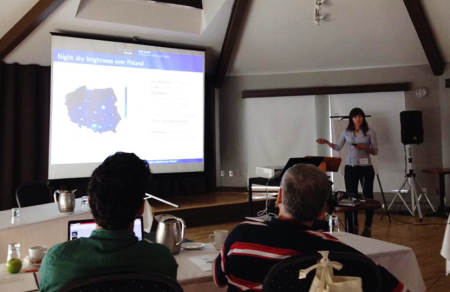
Light Pollution Researchers Gather In Québec

Light pollution researchers from around the world met at Jouvence, Québec, Canada from 26-28 May 2015 for the second biennial Light Pollution Theory, Modeling and Measurements (LPTMM) conference. Speakers at the meeting agreed that while our understanding of the fundamentals of skyglow is better than ever, new challenges emerge as we find the limits of technology for sensing light from the ground and from orbit, and the sophistication of light pollution models improves.
There are several broad conclusions from results presented at the three-day meeting:
Everyone now accepts the biological hazards of exposure to blue light at night, but people and governments still aren’t serious about solving the problem. Andreas Hänel (Museum am Scholerberg, Germany) noted that while German government agencies now warn about blue light, cities and towns continue using blue-rich white LEDs for outdoor lighting. Dr. Hänel suggested that future technology would enable mixing colors of light to avoid blue and help keep the sky dark for astronomical observations.
Models of light pollution are increasingly sophisticated but require much more validation with real-world data. Complex models are crucial for correct predictions of skyglow over cities. However, as Zoltán Kolláth (Univ. of Western Hungary) pointed out, we have to be very careful about interpreting new models because a complex model can match observations but involve a physically incorrect set of assumptions. But there is also hope that model quality can improve to the point where predictions are valid for long periods of time. Dan Duriscoe (U.S. National Park Service) suggested that we might eventually see a time when models are good enough that measurements to validate them are only needed “every few years.”
The brightness of the natural night sky varies more greatly than we thought. The result is a division in the modeling community, leading to rather different approaches in light-polluted places versus natural environments in which there is little or no artificial light. The difference isn’t trivial, leading to the impression that no one model may adequately account for both. Stefan Noll (University of Innsbruck) put it best: “Sky radiance modeling is challenging!”

The majority of researchers clearly see the limits of the Sky Quality Meter and the need for a new all-sky measurement standard. The SQM has enabled researchers to get scientific measuring instruments into the hands of people all over the world, but the limit of that technology is becoming apparent. The SQM samples only a fraction of the simply a matter of moving from the zenith to the horizon; we also need the spatial resolution that only imaging can provide. An increasing amount of effort is being put into development of all-sky imaging systems for precisely quantifying skyglow, with several examples presented at the meeting.
New tools are useful for both modelers and authorities that choose lighting for outdoor installations. Antoine Morin-Paulhus, an undergraduate student at the University of Sherbrooke, presented the Lamp Spectral Power Distribution Database. This free online tool provides complete spectral information for a large variety of commercially available lamps and their potential environmental impacts. Johanne Roby (Univ. of Sherbrooke) showed the results of a paper she coauthored with Martin Aubé on three new spectral indices useful for characterizing various lamps: MSI (Melatonin Suppression index), IPI (Induced Photosynthesis Index), and SLI (Star Light Index). Their idea is to help quantify the impacts of lighting in three key areas in order to help designers and consumers choose among commercial lighting products.
Addressing the needs of field practitioners. Kellie Pendoley (Pendoley Environmental Pty Ltd, Australia) gave a talk on her 25 years of sea turtle work and had a clear request of the meeting participants: Researchers need to provide short, concise summaries of their work to non-specialists, and most importantly, the results have to stand up in court. The impact to legal maneuvering around conservation efforts is where research results can have a big and very tangible impact, but they have to provide clear guidance.
More possibilities for citizen-science. Various talks mentioned or reported results derived from GLOBE At Night and the Loss Of The Night app. These citizen-science approaches have proven robust and capable of providing scientifically valid results. New measurement approaches will require further validation from widely distributed networks of ground observers. Jason Pun (Univ. of Hong Kong) summarized the situation best: “There’s a whole world of people out there waiting to help us.”

Attendees had many lively discussions during and after the presentations. These discussions are the starting point for assembling the agenda for the next LPTMM meeting, to be held in May 2017 at the Parc Astronòmic Montsec, Spain.



















